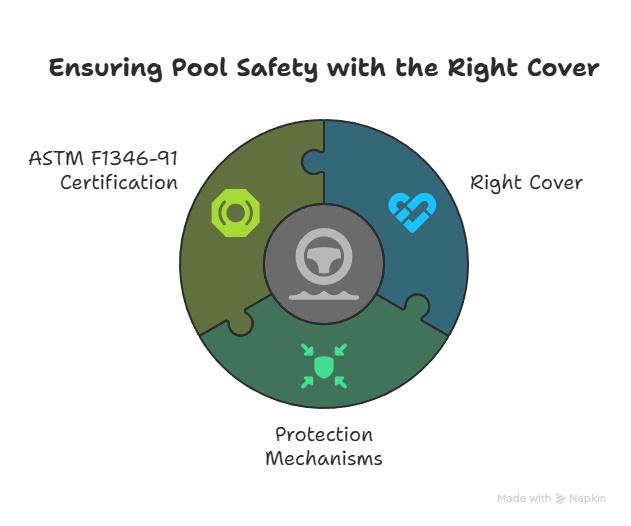Pool covers are essential for keeping your family and pool safe from accidents and environmental damage. But not all covers are created equal – understanding safety fundamentals is crucial for preventing potential tragedies.
Key Takeaways:
- Safety covers reduce child drowning risks by 75%
- Professional installation is critical
- Multiple safety features protect against accidents
- Regular maintenance ensures long-term protection
Understanding Pool Cover Safety Fundamentals
Pool safety isn’t just about having a cover – it’s about having the right cover with comprehensive protection mechanisms. The ASTM F1346-91 certification represents the gold standard for pool cover safety, ensuring rigorous testing and compliance.

Critical Safety Statistics
- 75% reduction in child drowning incidents with proper covers
- Minimum anchor system strength: 1,500 lbs per anchor
- Recommended cover replacement: 5-7 years for vinyl materials
Why Safety Matters: Comprehensive Protection
Unprotected pools pose significant risks to children and pets. A properly designed safety cover acts as a critical barrier, preventing accidental falls and unauthorized access.
Essential Safety Features
- Child-Proof Locking Systems
- Weight-Bearing Capacity
- Anti-Slip Surfaces
- Durable Materials
Types of Safety Pool Covers
Mesh Covers
- Allows water drainage
- Lightweight
- Potential risk for small pets
Solid Covers
- Complete water blockage
- Requires pump system
- Higher protection level
Hybrid Designs
- Combines mesh and solid technologies
- Enhanced safety features
- Customizable options
Professional Installation Matters
Professional installation ensures:
- Correct anchor placement
- Proper tension
- Seamless safety integration
💡 Pro Tip: Always hire certified professionals for pool cover installation.
Advanced Safety Technologies
Modern pool covers now integrate:
- Smart home systems
- Motion sensors
- Emergency access features
- Pet-specific enhancements
Legal and Insurance Considerations
Different regions have specific regulations:
- Florida: Strict building code requirements
- California: CPSC guideline compliance
Insurance Benefits:
- Premium discounts
- Liability protection
- Risk mitigation documentation
Choosing the Right Safety Cover
Evaluation Criteria:
- Load rating
- Material durability
- Customization options
- Budget considerations
Price Range (South African Rand)
| Cover Type | Price Range | Safety Level |
|---|---|---|
| Basic Mesh | R2,000 – R5,000 | Moderate |
| Solid Cover | R5,000 – R15,000 | High |
| Hybrid Design | R8,000 – R20,000 | Premium |
Maintenance and Long-Term Safety
Annual Safety Checklist:
- Inspect anchor points
- Check material integrity
- Lubricate mechanical components
- Professional safety audit
Conclusion
Investing in a high-quality swimming pool safety cover protects your loved ones and enhances pool area security. Prioritize professional installation and regular maintenance.
Recommended Next Steps
- Get professional assessment
- Choose ASTM-certified cover
- Schedule annual inspections
Disclaimer: Always consult local safety regulations and professional installers.